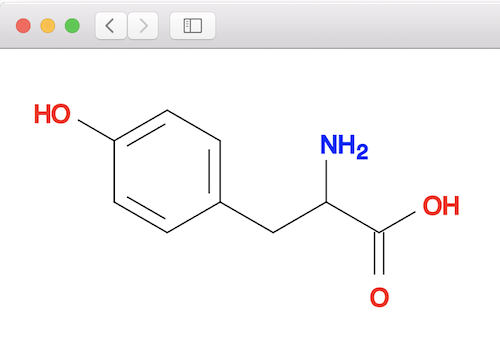Substructure Search with Wildcard Atom "*"
How to use Wildcard Atom in a substructure search using "babel" commands?
✍: FYIcenter.com
![]() You can use "*" in a SMARTS string as a wildcard atom to represent "ANY" atom
in a substructure search using "babel" commands.
You can use "*" in a SMARTS string as a wildcard atom to represent "ANY" atom
in a substructure search using "babel" commands.
Here are some examples of substructure matching with a wildcard atom "*" in the molecule pattern:
fyicenter$ obabel "-:c1cc(ccc1CC(C(=O)O)N)O" -o smiles -s O=CO c1cc(ccc1CC(C(=O)O)N)O 1 molecule converted fyicenter$ obabel "-:c1cc(ccc1CC(C(=O)O)N)O" -o smiles -s O=CC c1cc(ccc1CC(C(=O)O)N)O 1 molecule converted fyicenter$ obabel "-:c1cc(ccc1CC(C(=O)O)N)O" -o smiles -s O=C* c1cc(ccc1CC(C(=O)O)N)O 1 molecule converted fyicenter$ obabel "-:c1cc(ccc1CC(C(=O)O)N)O" -o smiles -s O=C*N c1cc(ccc1CC(C(=O)O)N)O 1 molecule converted fyicenter$ obabel "-:c1cc(ccc1CC(C(=O)O)N)O" -o smiles -s O=C*C c1cc(ccc1CC(C(=O)O)N)O 1 molecule converted fyicenter$ obabel "-:c1cc(ccc1CC(C(=O)O)N)O" -o smiles -s O=C** c1cc(ccc1CC(C(=O)O)N)O 1 molecule converted fyicenter$ obabel "-:c1cc(ccc1CC(C(=O)O)N)O" -o smiles -s O=C**ccccO c1cc(ccc1CC(C(=O)O)N)O 1 molecule converted fyicenter$ obabel "-:c1cc(ccc1CC(C(=O)O)N)O" -o smiles -s O=C******O c1cc(ccc1CC(C(=O)O)N)O 1 molecule converted fyicenter$ obabel "-:c1cc(ccc1CC(C(=O)O)N)O" -o smiles -s O=*******O c1cc(ccc1CC(C(=O)O)N)O 1 molecule converted
You can validate the above matching result by looking at the tyrosine molecule structure below:

⇒ Substructure Search with Wildcard Bond "~"
⇐ "babel -s ..." Command - Substructure Search
2020-06-08, 1622🔥, 0💬